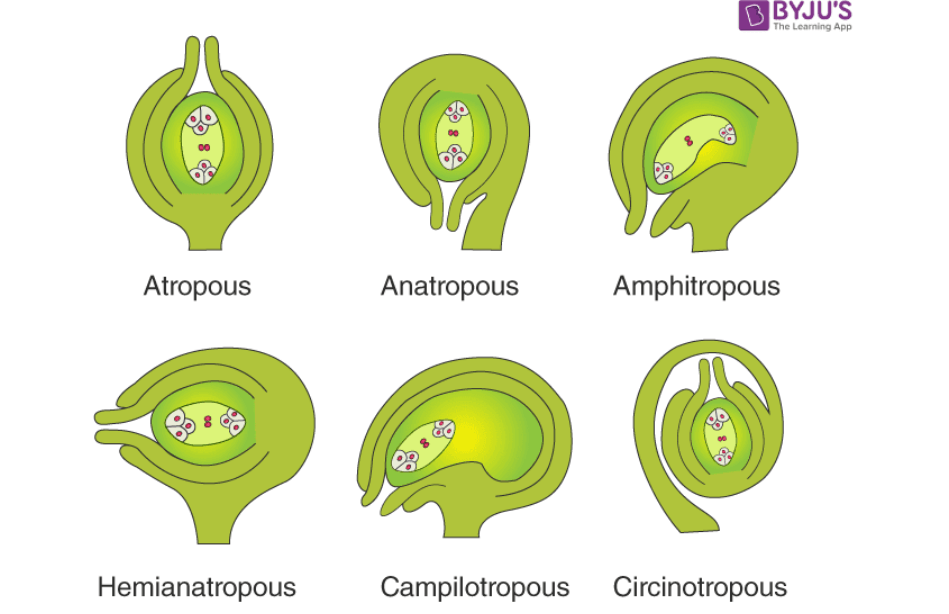Table of Contents
Definition
The ovule is a component of the female reproductive system of seed plants. It is where female reproductive parts are produced and maintained. Ovules are housed in ovaries at the base of the carpel, which includes an aperture at the top, stigma, and a neck called a style. After fertilisation, these cells eventually develop into a seed, which subsequently ripens to form a full-grown adult plant. Ovule is also known as the megasporangium in flowering plants.
After fertilisation, the ovule develops, and its wall begins to thicken to transform into a seed. In contrast, the ovary begins to grow around it and develop into the fruit. Remember that certain plants, such as the avocado, only have a single ovule in their ovary, whilst other plants, such as the kiwifruit, have numerous ovules, which eventually mature into multiple seeds in the fruit.
Location
The ovule is found inside the gynoecium, a part of the flower present in angiosperms or flowering plants. The fruit wall eventually develops from the ovary of the gynoecium, which produces more than one ovule. A funiculus structure, resembling a stalk, connects the ovules to the placenta. Plant species exhibit various ovule attachment or placentation patterns, including:
- Apical placentation
- Basal placentation
- Axile placentation
- Marginal placentation
- Free-central placentation
- Parietal placentation
- Superficial placentation
Ovules are born in gymnosperms, like conifers, usually inside an ovulate cone, on the surface of an ovule-bearing (ovuliferous) scale. Ovules were produced on the leaf surface in the earlier extinct seed ferns.
Types of Ovule
Based on their morphologies, ovules have been divided into six groups:

Amphitropous
The ovule’s body is so extensively curved that the ovule itself and the embryo sac resemble a horseshoe.
Orthotropous or Atropous
Here, the body of the ovules is straight, allowing the micropyle, the funicle connecting the ovule to the placenta, and the chalaza, where the integuments and nucellus combine, to be in alignment.
Anatropous
The ovules in this scenario inverted during development, causing the micropyle to be located near the hilum. A hilum scar denotes the spot where the funicle connected the seed to the fruit wall.
Hemi-anatropous
These ovules appear lying on their side because their bodies develop at right angles to the funicle.
Circinotropous
In this instance, the funicle is particularly long, forming a nearly complete circle around the ovule, whose micropyle eventually points upward.
Campylotropous
The coordination between the micropyle and chalaza is broken, and the body is bent. The embryo sac barely curves.
Components
The ovule is composed of the integuments forming the outermost layer, the nucellus, and the female gametophyte (known as an embryo sac in angiosperms), found in the core.
Integuments
A layer of protection surrounds the ovule called an integument. Once the ovule has undergone fertilisation, the integuments transform into the seed coat. Gymnosperms usually have one integument (unitegmic), whereas angiosperms typically possess two integuments (bitegmic).
The chalaza, where the nucellus and integuments are connected, is located across from the micropyle. The integuments do not entirely encase the nucellus; a small gap called the micropyle remains at the apex. A male gametophyte, pollen, can enter the ovule through the micropyle opening and fertilise it.
Nucellus
The most significant component of the ovule is the nucellus. It contains nutritive tissue and the embryo sac, and in some flowering plants, it is still present after fertilisation as a source of nutrition for the embryo.
The nucellus, a component of the ovule’s inner structure, forms a layer of sporophytic or diploid cells near the integuments. Nucellar embryony, an asexual reproduction process that occurs in some plants, allows the diploid nucellus tissue to give birth to the embryo inside the seed. The perisperm nourishing the embryo may grow from the nucellus after fertilisation.
Female Gametophyte
Gamete-producing sex components, essential for sexual reproduction, are located in this portion of the ovule. The female gametophyte is a haploid (single set of unpaired chromosomes) structure. It is also known as a megagametophyte or the embryo sac.
Functions
The ovule is an essential component in sexual reproduction. A pollen grain develops a pollen tube through the style after contacting the stigma of a flower of the same species. This tube subsequently reaches the ovary and travels to the ovule. After that, fertilisation can occur as the pollen grain’s nucleus travels down the tube to combine with the nucleus inside the embryo sac.
It should be noted that pollen, which includes the male gametophytes, serves as the male equivalent of the embryo sac.
Related Links:
Main Page:BYJU’S NEET
Comments